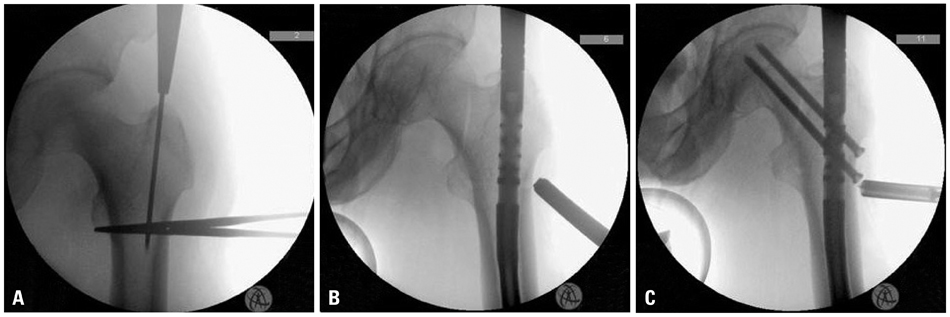Yonsei Med J.
2013 May;54(3):803-805. 10.3349/ymj.2013.54.3.803.
False Femoral Neck Fracture Detected during Shaft Nailing: A Mach Band Effect
- Affiliations
-
- 1Department of Orthopaedic Surgery, Gangnam Severance Hospital, Yonsei University College of Medicine, Seoul, Korea. kyang@yuhs.ac
- 2Department of Radiology, Gangnam Severance Hospital, Yonsei University College of Medicine, Seoul, Korea.
- KMID: 1727903
- DOI: http://doi.org/10.3349/ymj.2013.54.3.803
Abstract
- Femoral neck fractures are associated with femoral shaft fractures in 1% to 9% of cases. Undisplaced neck fractures are susceptible to displacement during shaft nailing. We report the case of a 57-year-old male patient in whom we performed standard intramedullary nailing for a femoral shaft fracture. In doing so, we identified a vertical radiolucent line at the femoral neck, which was thought to be further displacement of a hidden silent fracture or an iatrogenic fracture that developed during nail insertion. Consequently, we decided to switch to reconstructive femoral nailing. Postoperative hip imaging failed to show the femoral neck fracture that we saw in the operating room. Here, we discuss the aforementioned case and review the literature concerning this artifact.
Keyword
MeSH Terms
Figure
Reference
-
1. Tornetta P 3rd, Kain MS, Creevy WR. Diagnosis of femoral neck fractures in patients with a femoral shaft fracture. Improvement with a standard protocol. J Bone Joint Surg Am. 2007. 89:39–43.
Article2. Riemer BL, Butterfield SL, Ray RL, Daffner RH. Clandestine femoral neck fractures with ipsilateral diaphyseal fractures. J Orthop Trauma. 1993. 7:443–449.3. Yang KH, Han DY, Park HW, Kang HJ, Park JH. Fracture of the ipsilateral neck of the femur in shaft nailing. The role of CT in diagnosis. J Bone Joint Surg Br. 1998. 80:673–678.4. Park J, Yang KH. Correction of malalignment in proximal femoral nailing--reduction technique of displaced proximal fragment. Injury. 2010. 41:634–638.
Article5. Daffner RH. Skeletal pseudofractures. Emerg Radiol. 1995. 2:96–104.
Article
- Full Text Links
- Actions
-
Cited
- CITED
-
- Close
- Share
- Similar articles
-
- Fracture of Femur Neck Associated with Technical Errors in Closed Intramedullary Nailing of the Femur
- Value of Preoperative Bone Scan in Evaluation of Femur Shaft Fracture
- Clinical Evaluation of Complications of Interlocking Nail for Femoral Shaft Fracture
- Femur Neck Fracture during Closed Medullary Nailing of Femur Shaft Fracture: A Report of Two Cases
- Treatment of the Fractures of the Shaft of the Femur with Intramedullary Nailing



